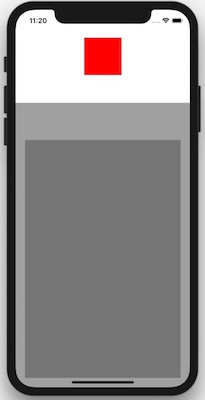Layoutable is an extension for UIView apps that make use of Auto Layout easier. This framework doesn't replace any existing Auto Layout API available in UIKit. Anchor API is very good and easy to use, but sometimes require a lot of code repetition for common tasks. This framework only adds a couple of useful extensions. You can check the implementation in just one single file.
Here's how the code would look like when constraining the screen above. See the example for the full version.
import UIKit
final class ViewController: UIViewController {
private let headerView: UIView = {
let view = UIView()
view.backgroundColor = .white
view.translatesAutoresizingMaskIntoConstraints = false
return view
}()
[...]
override func loadView() {
[...]
NSLayoutConstraint.activate([
headerView.topAnchor.constraint(equalTo: view.topAnchor),
headerView.leftAnchor.constraint(equalTo: view.leftAnchor),
headerView.rightAnchor.constraint(equalTo: view.rightAnchor),
headerView.heightAnchor.constraint(equalToConstant: 200),
headerCenterView.widthAnchor.constraint(equalToConstant: 80),
headerCenterView.heightAnchor.constraint(equalToConstant: 80),
headerCenterView.centerXAnchor.constraint(equalTo: headerView.centerXAnchor),
headerCenterView.centerYAnchor.constraint(equalTo: headerView.centerYAnchor),
contentContainerView.topAnchor.constraint(equalTo: headerView.bottomAnchor),
contentContainerView.leftAnchor.constraint(equalTo: view.leftAnchor),
contentContainerView.rightAnchor.constraint(equalTo: view.rightAnchor),
contentContainerView.bottomAnchor.constraint(equalTo: view.bottomAnchor),
contentView.topAnchor.constraint(equalTo: contentContainerView.topAnchor, constant: 80),
contentView.leftAnchor.constraint(equalTo: contentContainerView.leftAnchor, constant: 20),
contentView.rightAnchor.constraint(equalTo: contentContainerView.rightAnchor, constant: -20),
contentView.bottomAnchor.constraint(equalTo: contentContainerView.bottomAnchor, constant: -20),
])
}
}import UIKit
import Layoutable
final class ViewController: UIViewController {
private let headerView: UIView = {
let view = UIView()
view.backgroundColor = .white
return view.layoutable()
}()
[...]
override func loadView() {
[...]
headerView.constrainToSuperviewEdges(excluding: [.bottom])
headerView.heightAnchor.constraint(equalToConstant: 200).isActive = true
headerCenterView.constrainToConstant(size: .init(width: 80, height: 80))
headerCenterView.constrainCenterToSuperview()
contentContainerView.constrainToSuperviewEdges(excluding: [.top])
contentContainerView.topAnchor.constraint(equalTo: headerView.bottomAnchor).isActive = true
contentView.constrainToSuperviewEdges(insets: .init(top: 80, left: 20, bottom: 20, right: 20))
}
}For all of the views that you want to use with Auto Layout you have to type
translatesAutoresizingMaskIntoConstraints = false.
It's very easy to forget and have a lot of conflicts after running your app.
Layoutable checks for this situation and informs you how to fix it.
Layoutable supports iOS 9.0 or higher.
If you're using Carthage, add the following dependency to your Cartfile:
github "MichalTKwiecien/Layoutable" {version}If you're using CocoaPods, add the following dependency to your Podfile:
pod 'Layoutable', '~> {version}'You can just drag and drop single file to your project.
Development requires following tools:
After cloning the repository, install project's dependencies:
$ carthage bootstrap --platform iOS


